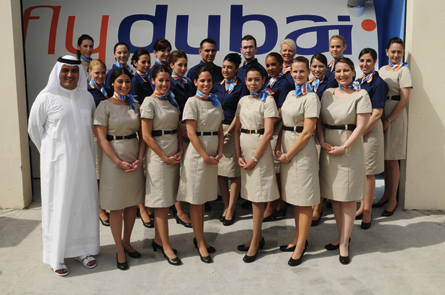Flydubai was spawned from Emirates in 2008 as an attempt by Dubai to lure a segment of the travelling public being lost to the large airline's full-service, widebody product. But the low-cost carrier - which launched services in June 2009 with a flight to Beirut - is anything but Emirates-lite. In its early days, the Boeing 737 operator relied on its big sister for most of its back-office functions. Today, however, any visible links with Emirates are few and flydubai has developed its own low-cost infrastructure and a clear identity in the market.
Its infrastructure includes a grey, two-storey prefabricated headquarters near Dubai International's low-cost Terminal 2 - a far cry from Emirates' palatial complex across the runway, with its leafy atrium crammed with restaurants. The airline has a fleet of 22 aircraft and goes to almost 50 destinations across 27 countries, all within a 5h radius that allows a return daily flight. Half its routes are also served by Emirates, although Ghaith Al Ghaith, the former Emirates executive who has run flydubai since the beginning, says there is no consultation with his former employer over route planning.
Flydubai's service is traditional unbundled no-frills - food, drink and even over-the-counter medicines are available to buy on board - with one exception. All its 44 new 737-800NGs - which are entering service now - come with a fibre-optics-based in-flight entertainment system from Lumexis, which offers passengers 150 movies as well as games, maps and news, and for which flydubai was launch customer in 2010. "This is one of the most innovative IFE systems ever and is a huge differentiator for us," says Al Ghaith. "We charge for the movies and we have already covered the running costs, including the additional fuel burn."
Life for flydubai's 315 flightcrew is very different to that of their counterparts at Dubai's flag-carrier too. Pilots are expected to live in or near Dubai and there is no overnighting. As with Air Arabia, they receive a flat salary and find and pay for their own accommodation. "The single payment works very well," says Al Ghaith. "People who work for us have the ability to manage their budget and their lifestyle. We don't like hidden costs."
 |
|---|
© Flydubai Al Ghaith with crew: "People who work for us can manage their budget and lifestyle" |
Flydubai arrived on the scene a year before launching services with a 50-aircraft order for 737-800s. "All we had at the time was a business plan and a brand," says Al Ghaith. All the aircraft will be delivered by 2016. The fleet growth will require another 300 pilots, which will be recruited at a rate of around 100 a year. So far, says Al Ghaith, finding the right candidates has not been difficult given the number of qualified 737 pilots around the world.
After almost three years of existence, Al Ghaith says the airline is where it wants to be. "Overall, I think we're in a better position. There are places we wanted to fly to that we don't, but also destinations we didn't think would be possible. We are still growing rapidly but we've matured," he says.
The airline has opened a training centre next to Dubai International's Terminal 2 and signed a deal with Dubai-based Emirates CAE Flight Training to be anchor tenant for the joint venture's second simulator centre in the city. Earlier this year, it launched a cargo operation. Beyond 2016, Al Ghaith is looking at further fleet expansion with either the 737 Max or the Airbus A320neo, and is keeping his options open. "It was a very marginal call when we opted for the 737 over the A320," he says. "Moving forward, we will be closely monitoring what both new types can offer."
Source: Flight International























